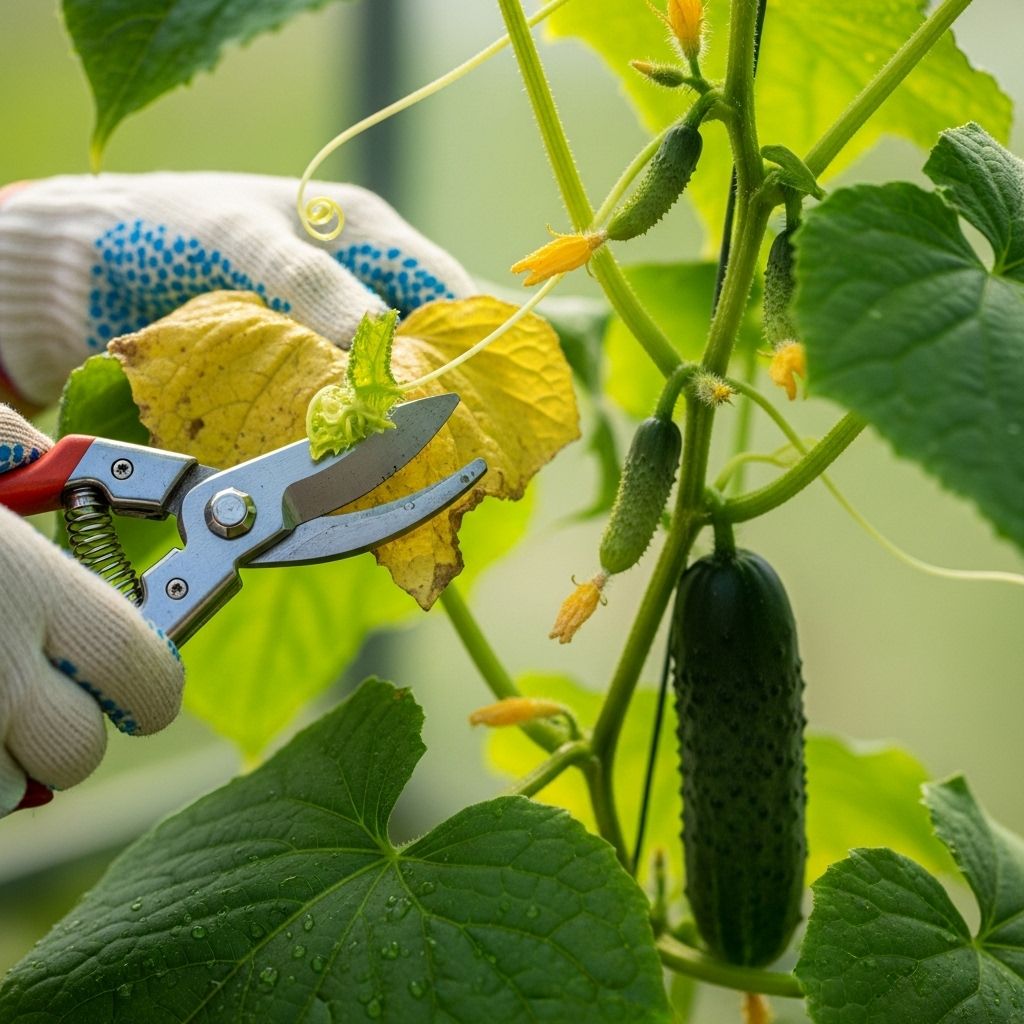How To Prune Cucumber Plants: 7-Step Guide To Bigger Harvests
Unlock maximum cucumber harvests by mastering the art and science of pruning for healthier, more productive vines.

Image: HearthJunction Design Team
Pruning Cucumbers: The Complete Guide for Healthier, More Productive Vines
Pruning may seem like an advanced gardening technique reserved for fruit trees and tomatoes, but your cucumber plants can also benefit greatly from regular pruning—especially when grown vertically. By understanding how, when, and why to prune cucumbers, you set the stage for healthier vines, larger fruits, and a longer-lasting harvest. This guide covers everything you need to know about pruning cucumbers for greater yields and healthier plants, with step-by-step instructions, troubleshooting tips, and frequently asked questions.
Contents
- Why Prune Cucumbers?
- When to Prune Cucumbers
- Tools and Preparation
- Step-by-Step: How to Prune Cucumber Plants
- Key Tips for Pruning Success
- Troubleshooting and Common Mistakes
- Frequently Asked Questions
Why Prune Cucumbers?
Pruning cucumbers isn’t just about keeping the plants tidy or reducing their size. It delivers several tangible benefits that can dramatically improve both the quality and quantity of your harvest:
- Improved Airflow: Removing excess leaves and stems opens up dense growth, reducing humidity and helping prevent pathogens like powdery mildew and downy mildew, which thrive in still, moist environments.
Cucumbers are usually grown in warm, humid conditions where airflow is naturally restricted—pruning counteracts this, making plants less susceptible to disease. - Bigger, Earlier Harvest: By pinching off suckers and directing energy to the main vine, your cucumber plant can develop larger, healthier fruit earlier in the season rather than expending resources on unnecessary foliage.
- Healthier Plants: Pruning away damaged, diseased, or overcrowded stems and leaves helps your plant stay vigorous and productive by encouraging strong, focused growth.
- Better Use of Space: Particularly when growing vertically, pruning prevents overcrowding and helps light penetrate deeper into the plant canopy, resulting in more even ripening and better all-around fruit quality.
When Should You Prune Cucumbers?
Timing is crucial. Start pruning once your cucumber vines have become established and are actively growing, but before they begin setting fruit in earnest. Here’s a quick guideline:
- Young plants: Begin pruning suckers when vines reach about 1–1.5 feet (30–45 cm) tall, concentrating on shoots that are less than 2 inches long.
- Ongoing maintenance: Continue to prune throughout the growing season, focusing on new suckers, spent flowers, or any lower leaves that touch the soil or block airflow.
- Stop heavy pruning: Once vines are loaded with maturing fruit, reduce pruning to avoid stressing the plant.
What Tools Do You Need?
Pruning cucumbers is a simple process that requires only a few basic tools:
- Clean, sharp pruning shears for larger stems and growth points.
- Your fingers for pinching off very small suckers (under 2 inches).
- Gloves (optional) to protect your hands from prickles or potential sap irritation.
- Sanitizing solution (e.g., isopropyl alcohol or a bleach solution) to clean your tools between cuts and between plants, reducing the risk of disease spread.
How to Prune Cucumber Plants: Step-by-Step Guide
Pruning technique differs slightly depending on how you grow your cucumbers. This guide focuses on vertical (trellised) cucumber plants, as pruning is less necessary for cucumbers sprawling along the ground. However, ground-grown plants can still benefit from the removal of diseased or damaged growth.
- Identify the Main Leader (Stem):
- Follow the main vine up from the base. This is the leader you want to encourage.
- Locate Growth Points (“Suckers”):
- Suckers are new shoots that emerge from the nodes—the points where a leaf meets the main stem. They usually grow in the “crotch” between the stem and a leaf, sometimes along with a small baby cucumber and a tendril.
Each node may contain:- The main leaf
- A tendril (for climbing)
- A potential cucumber fruit
- The growth point (sucker) that needs to be removed
- Suckers are new shoots that emerge from the nodes—the points where a leaf meets the main stem. They usually grow in the “crotch” between the stem and a leaf, sometimes along with a small baby cucumber and a tendril.
- Remove Young Suckers:
- When suckers are less than 2 inches long, simply pinch them off with your fingers for a clean break.
- Cut Larger Stems:
- If the sucker has grown larger, use sanitized pruning shears to cut it away. Make clean cuts close to—but not into—the main stem to avoid introducing disease.
- Continue Up the Vine:
- For trellised cucumbers, keep removing growth points up to the first 3 feet (about 1 meter) of the plant. After that, you can let some suckers grow if you want more fruiting branches—just ensure they don’t overcrowd the plant.
- Prune Damaged or Diseased Growth:
- Regularly inspect your plants for yellowing, damaged, or diseased leaves and stems. Remove these as soon as possible to keep your plant healthy.
- Thin Out Fruit and Lower Flowers:
- On vigorous plants, or with greenhouse/seedless types, remove lateral shoots, flowers, and fruits that develop on the lower 5–7 leaf nodes. This encourages the plant to mature and support later fruit higher up the vine, leading to better overall yield and quality.
Quick Reference Table: What to Remove and Why
| What to Remove | When | Why |
|---|---|---|
| Growth Points (Suckers) | Under 3 ft tall, under 2 inches long | Redirects energy to main stem and fruit Improves airflow |
| Damaged/Diseased Leaves | Anytime | Prevents disease spread, keeps plant healthy |
| Lateral Shoots, Lower Flowers/Fruit | First 5–7 nodes, esp. greenhouse types | Improves fruit quality & supports main growth |
| Older Leaves Touching Soil | As needed | Prevents soil-borne disease, improves airflow |
Key Tips for Pruning Success
- Be gentle: Avoid damaging the main stem or remaining leaves when removing suckers or cutting stems.
- Stay consistent: Regular, light pruning is better than infrequent, heavy cuts. Prune every week or two during periods of rapid growth.
- Always sanitize: Clean your shears after every plant (and after every cut if dealing with disease) to avoid spreading disease.
- Trellis support: Train remaining vines and tendrils to follow your trellis for the best light exposure and fruit development.
- Water and feed well: Healthy, well-nourished plants respond better to pruning and bounce back quickly.
Troubleshooting and Common Pruning Mistakes
- Over-pruning: Removing too many leaves and stems can stress the plant, reduce photosynthesis, and ultimately harm your harvest. Always leave enough foliage to support healthy growth.
- Ignoring airflow: If your plant canopy is too dense, disease can quickly set in. Err on the side of a slightly more open structure.
- Missing young suckers: Small suckers are easy to remove, but if left unchecked, they quickly become large and difficult to pinch off without damage.
- Neglecting ground-grown cucumbers: While sprawling vines need less pruning, periodically check and remove damaged or diseased growth and excess lower leaves for best results.
- Skipping cleaning tools: Dirty or dull tools spread disease and can tear rather than cleanly cut stems.
Frequently Asked Questions (FAQs)
Q: Should I prune cucumbers that grow along the ground?
A: You generally do not need to prune ground-grown cucumbers except to remove damaged, diseased, or overcrowded leaves. Vertical, trellised plants benefit most from regular pruning.
Q: Can I prune flower buds and still get a good harvest?
A: Yes, especially on young or greenhouse/seedless types. Removing lower flowers and fruits in the first 5–7 leaf nodes encourages better growth and bigger harvests later in the season.
Q: Will pruning reduce my cucumber yield?
A: When done correctly, pruning actually increases your yield by focusing the plant’s resources on fewer, healthier fruits. Over-pruning can reduce yield, so always strive for balance.
Q: How often should I prune my cucumber plants?
A: Check your cucumbers every week, especially during the peak of their growth. Remove new suckers, spent flowers, or lower leaves as needed to keep the canopy open and healthy.
Q: What’s the difference between a sucker, a tendril, and a fruit?
A: Each node can produce several different structures:
- Sucker: A new shoot that, if left, will become another vine or branch—these are generally removed for airflow and focus.
- Tendril: A curly structure that helps the plant climb and anchor itself to a trellis.
- Fruit: The baby cucumber that forms just above the node, usually kept for harvest.
Q: What should I do with pruned material?
A: Discard pruned material, particularly if it shows signs of disease, away from the garden or compost. Healthy leaves and stems can be composted.
Q: Can I prune cucumbers late in the season?
A: Yes, but avoid heavy pruning when plants are loaded with fruit, as this can stress the plant. Focus on removing diseased or yellowing leaves only at this stage.
Conclusion
Regularly pruning your cucumber plants—especially those grown on a trellis—pays off with a healthier, more manageable vine and bigger, tastier fruit. Start early, be gentle, and stay consistent. The art of pruning is as much about observation as it is about cutting, and by becoming attuned to your plants’ needs, you’ll enjoy delicious cucumbers all summer long.
References
Read full bio of Anjali Sayee












